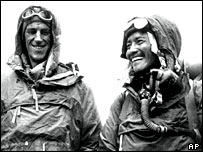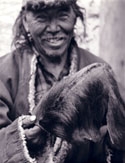
January 10, 2008

Sir Edmund Hillary, one of the first two men to climb the world’s highest mountain, Mount Everest, has died at the age of 88, on January 11, 2008, local New Zealand time. He climbed the 29,035 ft (8,850m) peak with Sherpa Tenzing Norgay, reaching the top on May 29, 1953.
Hillary’s health had reportedly been in decline since April 2007, after a fall while visiting Nepal. He suffered a heart attack in hospital on Friday morning.

Sir Edmund’s fellow climber, Sherpa Tenzing Norgay (right), died in May 1986.
Born July 20, 1919, in Auckland, New Zealand, Sir Edmund Hillary began climbing mountains in his native country as a teenager and earned renown as an ice climber.
He served as a pilot during World War II and as New Zealand’s ambassador to India in the 1980s.
Within cryptozoology, Sir Edmund Hillary will be remembered, first as a man who hunted Abominable Snowmen, and then one who later would debunk the Yeti.
In the 1950s, curiosity about the identity of the “Abominable Snowman” drew Edmund Hillary into the search. Stories of hairy man-like creatures were known. Footprints in the snow and in mud were found to indicate some such cryptids were active in out of the way places in Nepal, Tibet, and the surrounding region.
In 1952, Hillary along with George Lowe found hair on a high pass while in the mountains, relating it to Yeti.
In 1953, Yeti tracks were found by Hillary in the Barun Khola range. The next year, two British members of Hillary’s team discovered Yeti tracks in the Choyang Valley. His trusted Sherpa friends would tell Hillary of their firsthand sightings of the man-sized Yeti.
The Sherpas in Nepal know of several types of “Abominable Snowmen” in the mountains of Asia.
When Hillary went to the Himalayas to look for the Yeti, he and his collaborator, journalist Desmond Doig, noted that there were several unknown primates said to be there still undiscovered in any formal way.
Among the varieties was one called the “Nyalmo.” Hillary and Doig learned of the Nyalmo in north-central Nepal. It was said to be “giant-sized (up to twenty feet tall), manlike, hairy, and given to shaking giant pine trees in trials of strength while other Nyalmos sit around and clap their hands.”
During most of the 1950s, Hillary was a supporter for the possibility of the existence of the Yeti.
Late in 1960, Sir Edmund Hillary, sponsored by the World Book encyclopedia company of Chicago, left on his (in)famous expedition to Nepal in pursuit of the “Abominable Snowman.”

The scalp at the Khumjung monastery, Nepal, examined by his expedition was reported to be over 350 years old. This scalp was borrowed by Sir Edmund Hillary in 1960 and examined by specialists at the Field Museum in Chicago. It was made from the skin of a Himalayan goat-antelope, the serow (Naemorhedus sumatraensis). Of course, Hillary already knew this because he had a copy made for him before he left Nepal.
Edmund Hillary’s 1960 Himalayan Scientific and Mountaineering Expedition (also called the World Book expedition) concluded that Yeti tracks were distortions of human footprints melted by the snow, that Yeti sightings by Sherpas were unreliable because the mountain porters did not make a distinction between the supernatural and the real worlds, and that all the scalps were probably fakes. At least that is the overt story told to the media. But there may have been a covert mission, as well.
Hillary’s “Yeti expedition” has been critiqued in such books as Ivan T. Sanderson’s Appendix E, “Sir Edmund Hillary’s Scalp – A News Story from Nepal” in Abominable Snowmen: Legend Come to Life and in the section “Hillary’s Assassination of the Yeti” in Tom Slick: True Life Encounters in Cryptozoology . (While I was writing my Slick book in the 1980s, Hillary kindly wrote me a letter answering some questions I had asked him about his knowledge of Slick. His reply demonstrated he was a gentleman and an adventurer, always.)
In the end, Hillary would sum up his sense of the Abominable Snowman with these words: “I am inclined to think that the realm of mythology is where the Yeti rightly belongs.”
The Hillary-Marlin Perkins effort to discover the reality behind the Snowman appears to be have been a smokescreen.
While Tom Slick’s 1957-1959 expeditions may have been rumored to be espionage missions, what part did spying play in Hillary’s trek? Driven by the media, most accounts of the Yeti debunking affair mention only the high altitude medical testing as another subobjective of Hillary’s efforts. A few English and Italian press accounts, however, exist confirming that one other goal of the group was to spy on the Chinese in Tibet.
Two rocket experts, Tom Nevison of the United States Air Force and Peter Mulgrew, a radio expert with the Royal New Zealand Navy, were closely watching and gathering data on the Chinese firing missiles from Tibet. Journalist Desmond Doig, Nevison and Mulgrew were camped together at Tolum Bau glacier when they all witnessed just such a launching. Meanwhile, the Chinese were jamming the Hillary camp’s radio.
In a sad twist of fate, Sir Edmund Hillary’s first wife, Louise, and daughter, Belinda, 16, died in a 1975 plane crash near Kathmandu, Nepal. Then Hillary’s friend, Peter Mulgrew died when Air New Zealand Flight 901, a DC-10 crashed on Mt Erebus, Antarctic, November 28, 1979. Hillary and Mulgrew’s widow, June, grew close and married.
One of the great ones from that famed 1950s-1960s generation of Yeti hunters is now gone. How sad.
^^^^^^^^^^^^^^^^^
For more, please see:
My Favorite Hillary & Yeti Photo.
About Loren Coleman
Loren Coleman is one of the world’s leading cryptozoologists, some say “the” leading living cryptozoologist. Certainly, he is acknowledged as the current living American researcher and writer who has most popularized cryptozoology in the late 20th and early 21st centuries.
Starting his fieldwork and investigations in 1960, after traveling and trekking extensively in pursuit of cryptozoological mysteries, Coleman began writing to share his experiences in 1969. An honorary member of Ivan T. Sanderson’s Society for the Investigation of the Unexplained in the 1970s, Coleman has been bestowed with similar honorary memberships of the North Idaho College Cryptozoology Club in 1983, and in subsequent years, that of the British Columbia Scientific Cryptozoology Club, CryptoSafari International, and other international organizations. He was also a Life Member and Benefactor of the International Society of Cryptozoology (now-defunct).
Loren Coleman’s daily blog, as a member of the Cryptomundo Team, served as an ongoing avenue of communication for the ever-growing body of cryptozoo news from 2005 through 2013. He returned as an infrequent contributor beginning Halloween week of 2015.
Coleman is the founder in 2003, and current director of the International Cryptozoology Museum in Portland, Maine.
Filed under Abominable Snowman, Breaking News, Conspiracies, Cryptomundo Exclusive, Cryptotourism, CryptoZoo News, Cryptozoologists, Cryptozoology, Expedition Reports, Eyewitness Accounts, Footprint Evidence, Media Appearances, Men in Cryptozoology, Obituaries, Photos, Pop Culture, Yeti